2013 DODGE CHARGER coolant level
[x] Cancel search: coolant levelPage 558 of 631
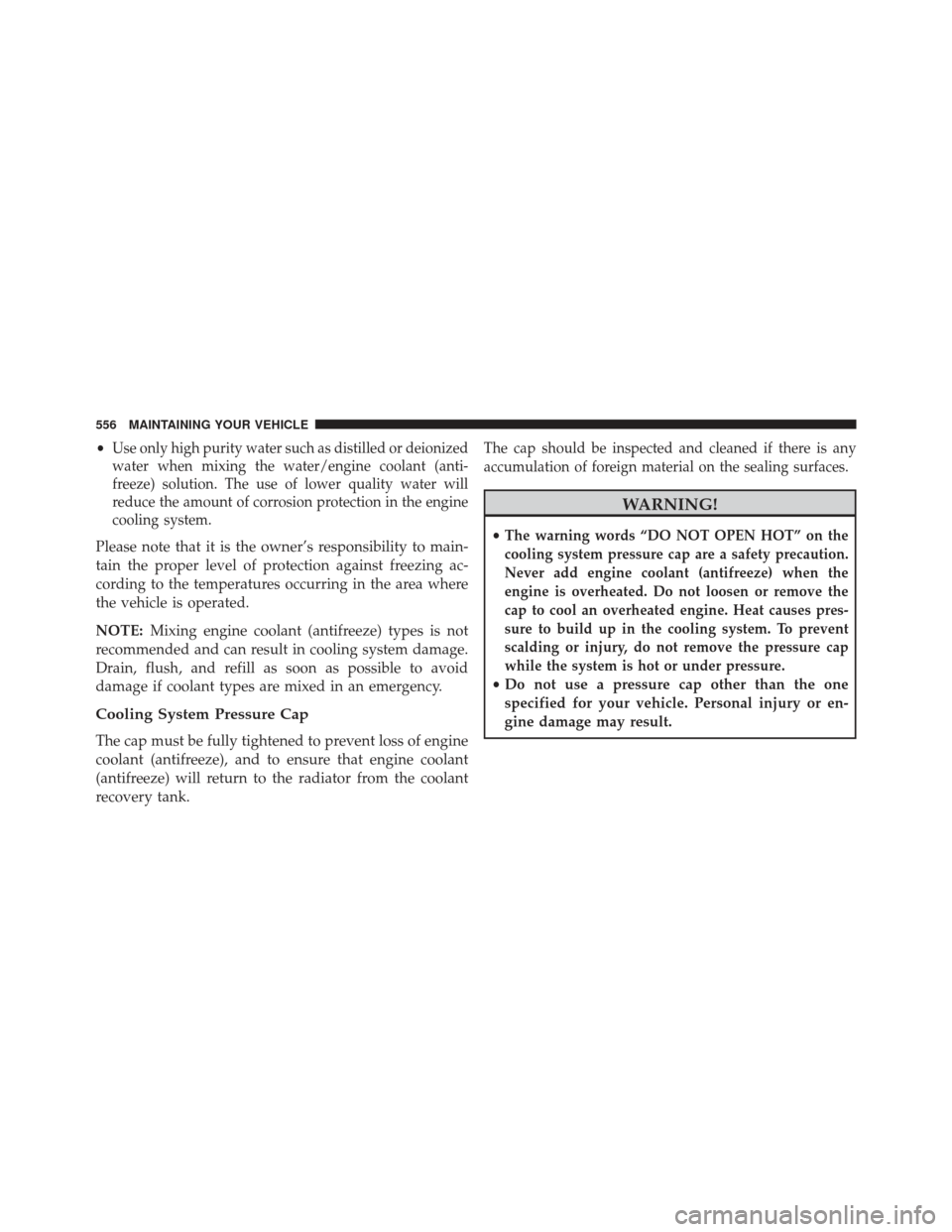
•Use only high purity water such as distilled or deionized
water when mixing the water/engine coolant (anti-
freeze) solution. The use of lower quality water will
reduce the amount of corrosion protection in the engine
cooling system.
Please note that it is the owner’s responsibility to main-
tain the proper level of protection against freezing ac-
cording to the temperatures occurring in the area where
the vehicle is operated.
NOTE: Mixing engine coolant (antifreeze) types is not
recommended and can result in cooling system damage.
Drain, flush, and refill as soon as possible to avoid
damage if coolant types are mixed in an emergency.
Cooling System Pressure Cap
The cap must be fully tightened to prevent loss of engine
coolant (antifreeze), and to ensure that engine coolant
(antifreeze) will return to the radiator from the coolant
recovery tank.
The cap should be inspected and cleaned if there is any
accumulation of foreign material on the sealing surfaces.
WARNING!
•The warning words “DO NOT OPEN HOT” on the
cooling system pressure cap are a safety precaution.
Never add engine coolant (antifreeze) when the
engine is overheated. Do not loosen or remove the
cap to cool an overheated engine. Heat causes pres-
sure to build up in the cooling system. To prevent
scalding or injury, do not remove the pressure cap
while the system is hot or under pressure.
• Do not use a pressure cap other than the one
specified for your vehicle. Personal injury or en-
gine damage may result.
556 MAINTAINING YOUR VEHICLE
Page 559 of 631
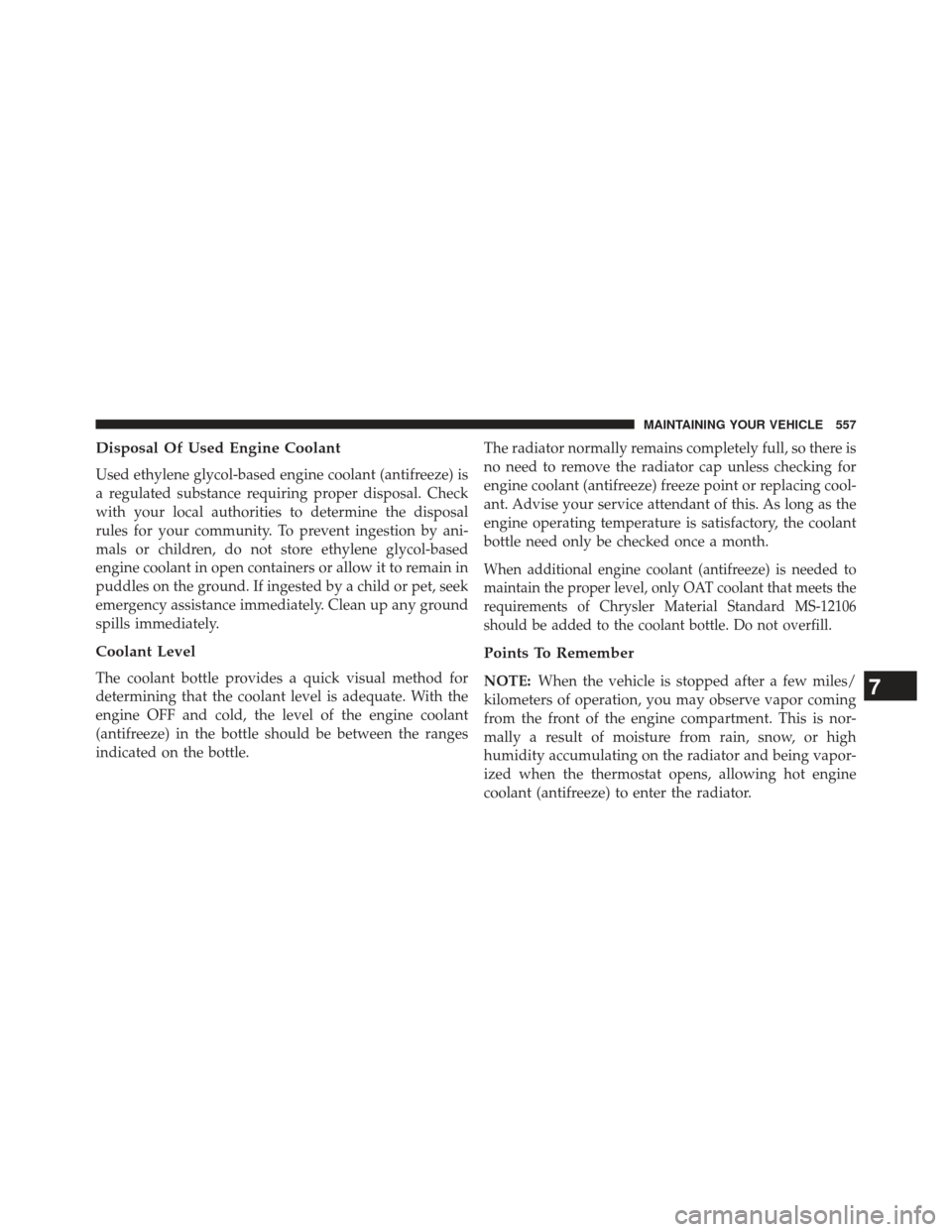
Disposal Of Used Engine Coolant
Used ethylene glycol-based engine coolant (antifreeze) is
a regulated substance requiring proper disposal. Check
with your local authorities to determine the disposal
rules for your community. To prevent ingestion by ani-
mals or children, do not store ethylene glycol-based
engine coolant in open containers or allow it to remain in
puddles on the ground. If ingested by a child or pet, seek
emergency assistance immediately. Clean up any ground
spills immediately.
Coolant Level
The coolant bottle provides a quick visual method for
determining that the coolant level is adequate. With the
engine OFF and cold, the level of the engine coolant
(antifreeze) in the bottle should be between the ranges
indicated on the bottle.The radiator normally remains completely full, so there is
no need to remove the radiator cap unless checking for
engine coolant (antifreeze) freeze point or replacing cool-
ant. Advise your service attendant of this. As long as the
engine operating temperature is satisfactory, the coolant
bottle need only be checked once a month.
When additional engine coolant (antifreeze) is needed to
maintain the proper level, only OAT coolant that meets the
requirements of Chrysler Material Standard MS-12106
should be added to the coolant bottle. Do not overfill.
Points To Remember
NOTE:
When the vehicle is stopped after a few miles/
kilometers of operation, you may observe vapor coming
from the front of the engine compartment. This is nor-
mally a result of moisture from rain, snow, or high
humidity accumulating on the radiator and being vapor-
ized when the thermostat opens, allowing hot engine
coolant (antifreeze) to enter the radiator.7
MAINTAINING YOUR VEHICLE 557
Page 586 of 631
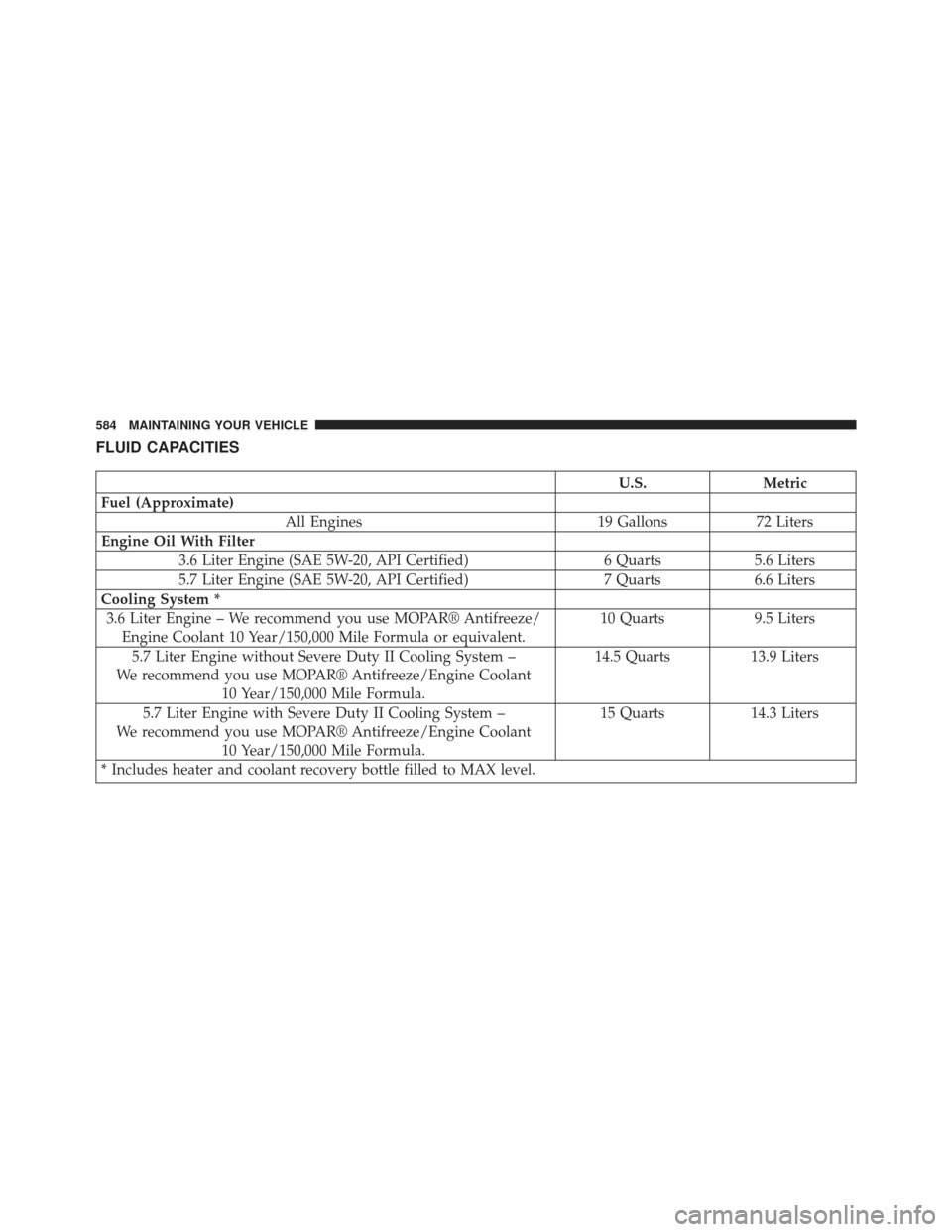
FLUID CAPACITIES
U.S.Metric
Fuel (Approximate) All Engines 19 Gallons72 Liters
Engine Oil With Filter 3.6 Liter Engine (SAE 5W-20, API Certified) 6 Quarts5.6 Liters
5.7 Liter Engine (SAE 5W-20, API Certified) 7 Quarts6.6 Liters
Cooling System * 3.6 Liter Engine – We recommend you use MOPAR® Antifreeze/ Engine Coolant 10 Year/150,000 Mile Formula or equivalent. 10 Quarts
9.5 Liters
5.7 Liter Engine without Severe Duty II Cooling System –
We recommend you use MOPAR® Antifreeze/Engine Coolant 10 Year/150,000 Mile Formula. 14.5 Quarts
13.9 Liters
5.7 Liter Engine with Severe Duty II Cooling System –
We recommend you use MOPAR® Antifreeze/Engine Coolant 10 Year/150,000 Mile Formula. 15 Quarts
14.3 Liters
* Includes heater and coolant recovery bottle filled to MAX level.
584 MAINTAINING YOUR VEHICLE
Page 591 of 631
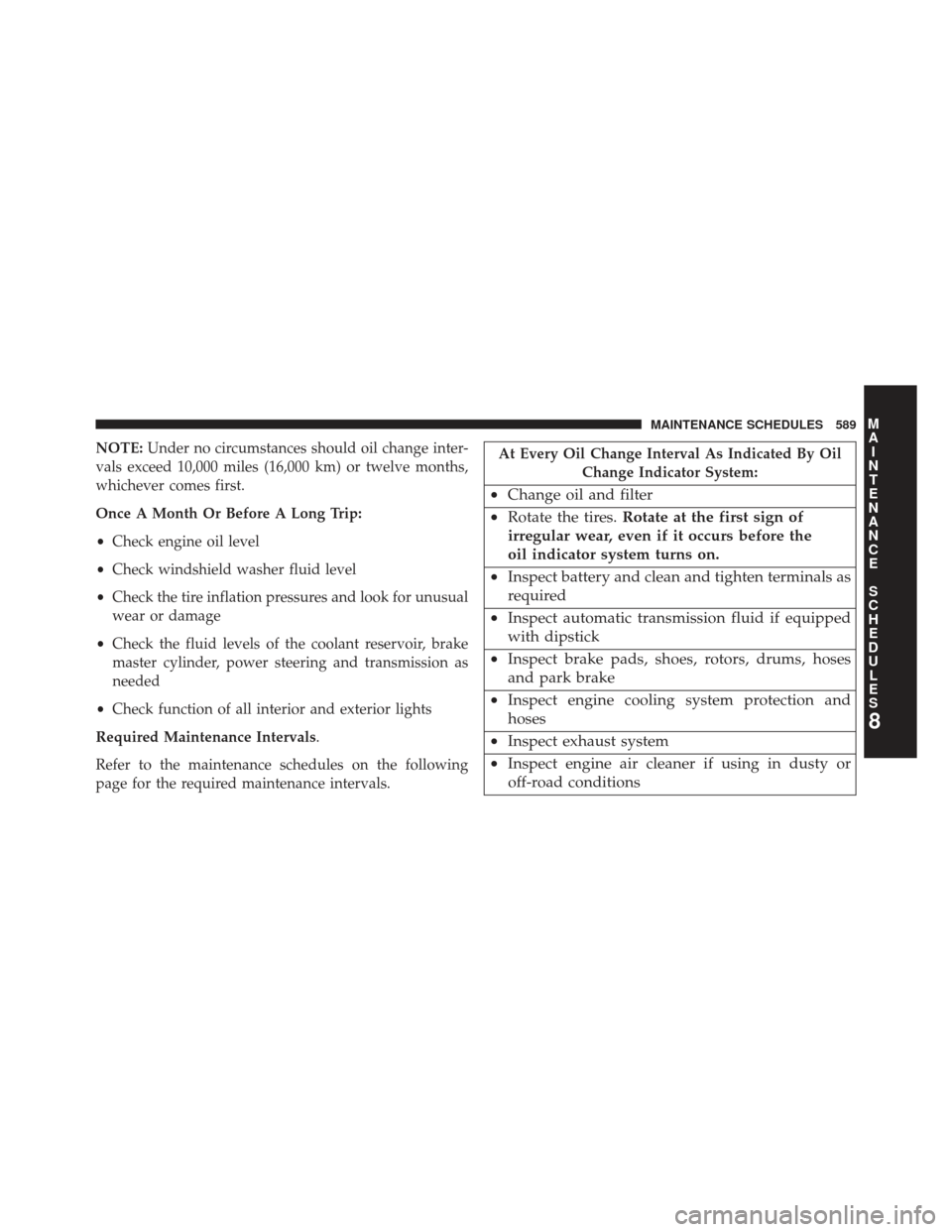
NOTE:Under no circumstances should oil change inter-
vals exceed 10,000 miles (16,000 km) or twelve months,
whichever comes first.
Once A Month Or Before A Long Trip:
• Check engine oil level
• Check windshield washer fluid level
• Check the tire inflation pressures and look for unusual
wear or damage
• Check the fluid levels of the coolant reservoir, brake
master cylinder, power steering and transmission as
needed
• Check function of all interior and exterior lights
Required Maintenance Intervals.
Refer to the maintenance schedules on the following
page for the required maintenance intervals.At Every Oil Change Interval As Indicated By Oil Change Indicator System:
•Change oil and filter
• Rotate the tires. Rotate at the first sign of
irregular wear, even if it occurs before the
oil indicator system turns on.
• Inspect battery and clean and tighten terminals as
required
• Inspect automatic transmission fluid if equipped
with dipstick
• Inspect brake pads, shoes, rotors, drums, hoses
and park brake
• Inspect engine cooling system protection and
hoses
• Inspect exhaust system
• Inspect engine air cleaner if using in dusty or
off-road conditions
8
M
A I
N T
E
N
A
N
C E
S
C
H E
D
U L
E
SMAINTENANCE SCHEDULES 589
Page 613 of 631
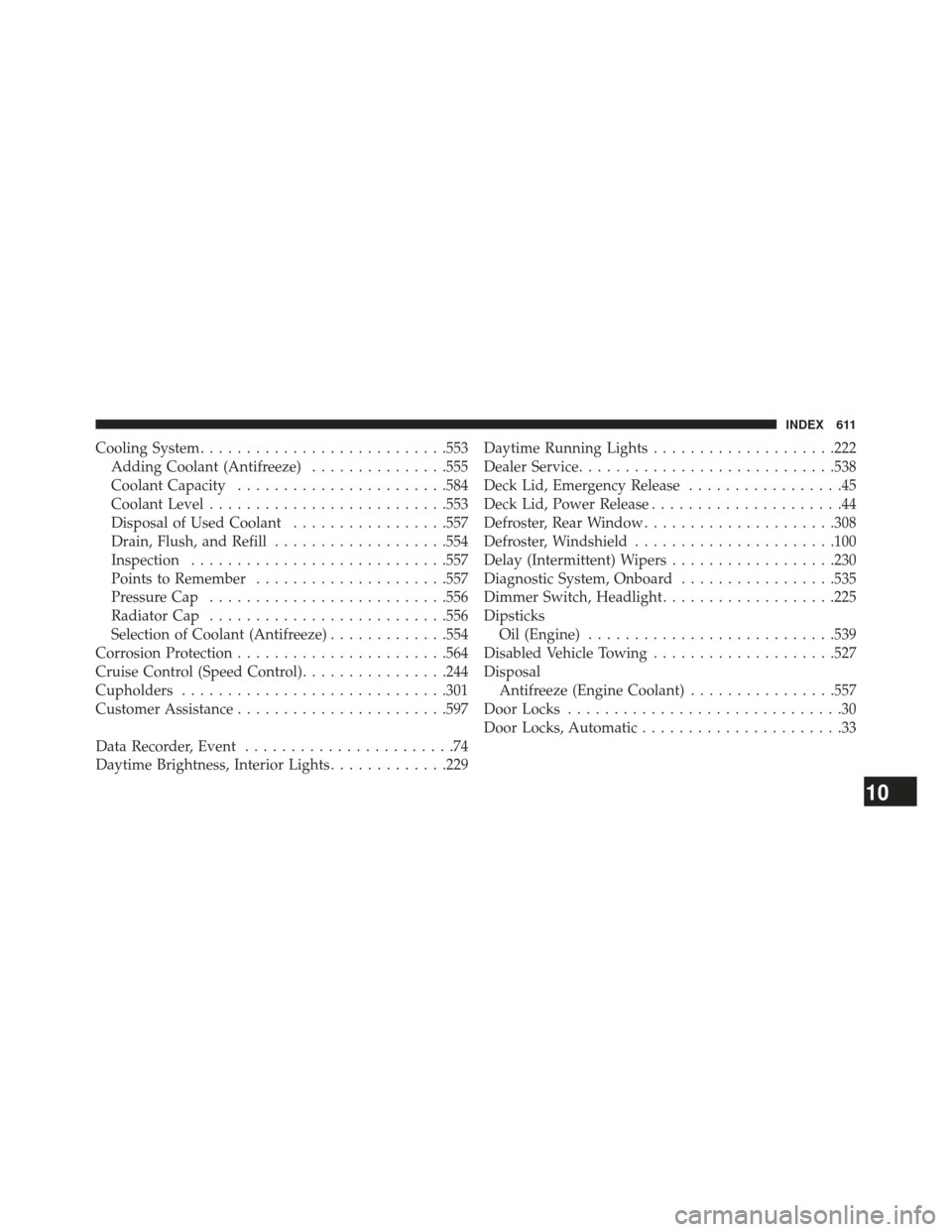
Cooling System.......................... .553
Adding Coolant (Antifreeze) ...............555
Coolant Capacity ...................... .584
Coolant Level ......................... .553
Disposal of Used Coolant .................557
Drain, Flush, and Refill ...................554
Inspection ........................... .557
Points to Remember .....................557
Pressure Cap ......................... .556
Radiator Cap ......................... .556
Selection of Coolant (Antifreeze) .............554
Corrosion Protection ...................... .564
Cruise Control (Speed Control) ................244
Cupholders ............................ .301
Customer Assistance ...................... .597
Data Recorder, Event .......................74
Daytime Brightness, Interior Lights .............229Daytime Running Lights
....................222
Dealer Service ........................... .538
Deck Lid, Emergency Release .................45
Deck Lid, Power Release .....................44
Defroster, Rear Window .....................308
Defroster, Windshield ..................... .100
Delay (Intermittent) Wipers ..................230
Diagnostic System, Onboard .................535
Dimmer Switch, Headlight ...................225
Dipsticks Oil (Engine) .......................... .539
Disabled Vehicle Towing ....................527
Disposal Antifreeze (Engine Coolant) ................557
Door Locks ..............................30
Door Locks, Automatic ......................33
10
INDEX 611
Page 614 of 631
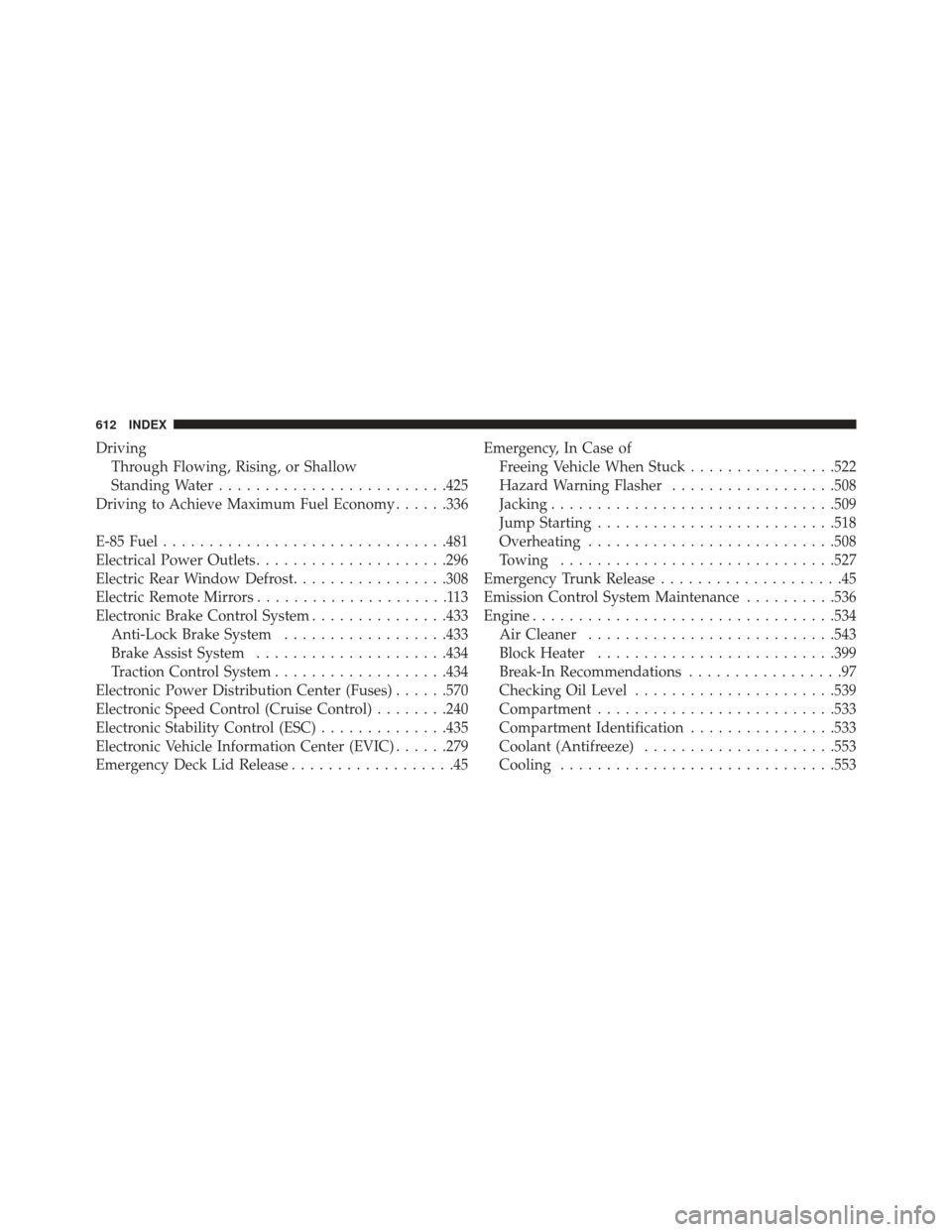
DrivingThrough Flowing, Rising, or Shallow
Standing Water ........................ .425
Driving to Achieve Maximum Fuel Economy ......336
E-85 Fuel .............................. .481
Electrical Power Outlets .....................296
Electric Rear Window Defrost .................308
Electric Remote Mirrors .....................113
Electronic Brake Control System ...............433
Anti-Lock Brake System ..................433
Brake Assist System .....................434
Traction Control System ...................434
Electronic Power Distribution Center (Fuses) ......570
Electronic Speed Control (Cruise Control) ........240
Electronic Stability Control (ESC) ..............435
Electronic Vehicle Information Center (EVIC) ......279
Emergency Deck Lid Release ..................45Emergency, In Case of
Freeing Vehicle When Stuck ................522
Hazard Warning Flasher ..................508
Jacking .............................. .509
Jump Starting ......................... .518
Overheating .......................... .508
Towing ............................. .527
Emergency Trunk Release ....................45
Emission Control System Maintenance ..........536
Engine ................................ .534
Air Cleaner .......................... .543
Block Heater ......................... .399
Break-In Recommendations .................97
Checking Oil Level ..................... .539
Compartment ......................... .533
Compartment Identification ................533
Coolant (Antifreeze) .....................553
Cooling ............................. .553
612 INDEX